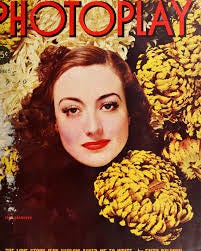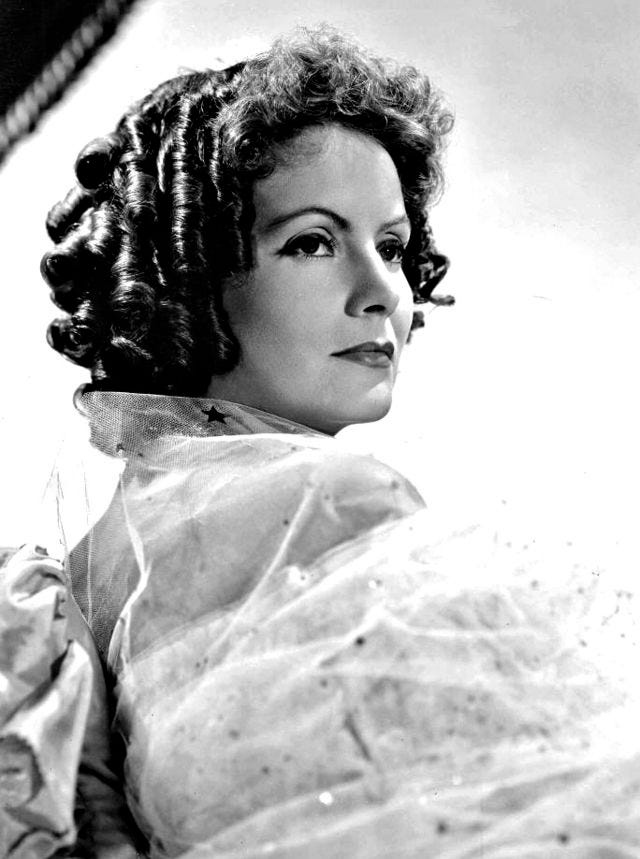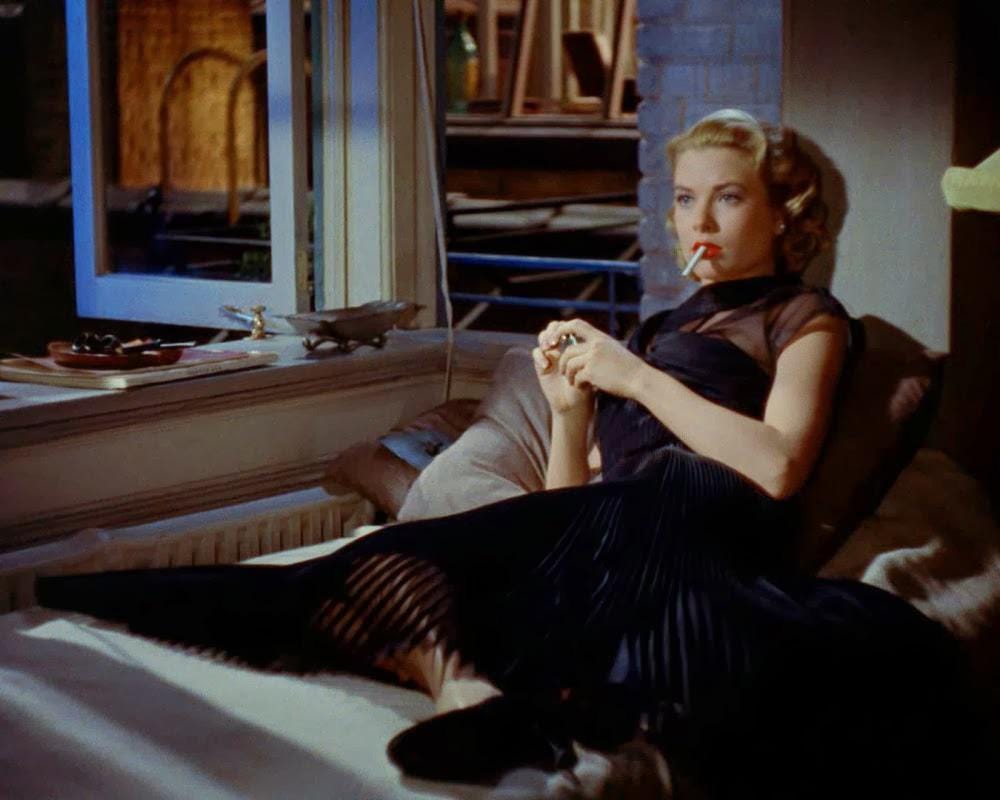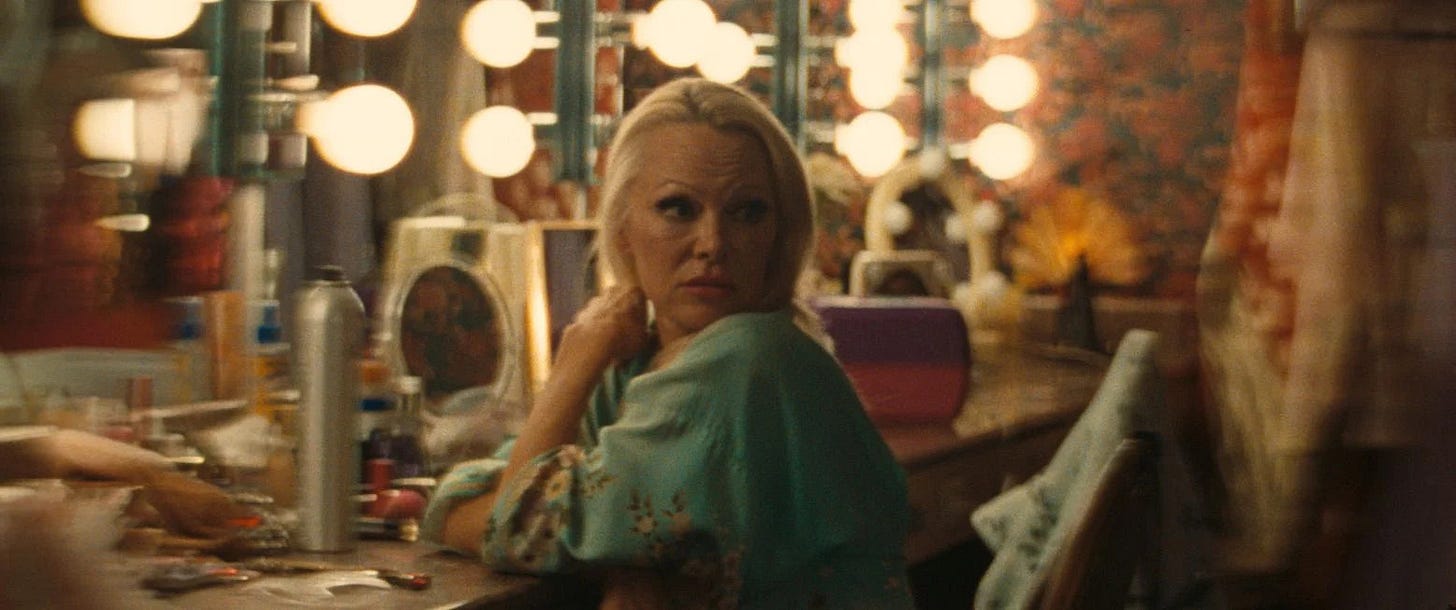Between Performance and Persona: Meta-Realism and Female Film Stardom
Actors have always drawn on elements of internal experience or life story, but a recent wave of films featuring iconic female stars consciously elides the space between performance & subjectivity.
There’s a sequence early in Halina Reijn’s Babygirl where Romy Mathis, a workaholic CEO of a robotic infrastructure company played by Nicole Kidman, endures a series of cosmetic treatments. She is injected with Botox, undergoes cryotherapy, and receives light therapy—all captured with an insistent, unrelenting gaze. The specificity of this montage lands as a meta-commentary on Kidman’s own physical appearance, which—and this isn’t particularly controversial to note—has visibly changed through cosmetic intervention.
The scene exemplifies a specific kind of address to the viewer, a call to “read” the symbiosis between Kidman (the actor) and Romy (the character). This requires the director and performer to acknowledge and utilise an implied audience “meta-recognition” which is textual, subtextual and extra textual. Our knowledge and perception of a star is shaped through the roles in which we have seen them, but also by the wider context of celebrity culture.
Throughout, Babygirl deliberately activates such layering: facets of Kidman’s identity are aligned with the character she is playing. And we are being allowed—even encouraged—to draw those parallels.
A pointed line of dialogue delivered by Romy’s teenage daughter Isobel exemplifies this. “Why do you do this to yourself?” she asks in voiceover.
Is this question laced with cruelty or concern? Either way, the film relies on the viewer being aligned, at least partially, with the daughter’s judgmental position. The character is asking her mother—but I would argue that we, the implied viewers, are directing the question at a different “you.”
It’s an instance where the character becomes secondary—or at least refracted through—our perception of the actor/star/persona. “Why do you do this to yourself, Nicole?” (my emphasis).
Adrian Horton, in her review of the film in The Guardian, uses a familiar attribution often applied when actors are seen to move beyond mere pretence toward something more authentically revealing:
“Perhaps the bravest moment in a performance rightfully hailed as brave—not actually devoid of fear, rather pushing through it for something genuinely startling—is when Kidman, as Romy, subjects her face to a clinical white light and a Botox needle, blurring the line between female CEO enduring the relentless pressures of ageing, and Kidman the actor with a face so notoriously stiff it has confined her to playing rich women.”
“Brave” is one of those contingent, often slippery terms-freighted with moral weight. In this context, it becomes a kind of euphemism, a stand-in for what is ultimately a form of controlled self-exposure. Bravery here signals a willingness to engage with the intimate, culturally loaded terrain of aging and female embodiment, particularly within a cinematic frame. It is a bravery of visibility, of showing the labour and consequences of maintaining the very image the industry demands.
But the bravery in Babygirl goes deeper than the mere act of allowing one’s face to be seen under harsh lighting or subjected to the needle. That kind of visibility, allowing oneself to become a spectacle, has long been part of the actor’s terrain. What feels more pointed, unsettling, maybe even contradictory, is the way the film, through both its narrative and character psychology, builds a structure around that spectacle. Kidman isn’t simply offering herself up to a forensic gaze; she is participating in a more layered exploration of identity and control.
The film, then, does not utilise Kidman’s face and body in the narrow service of character and story; it creates a space in which the line between character and actor, fiction and cultural memory, is not just blurred but productively unstable. The bravery, if we can still call it that, lies in Kidman’s willingness to foreground that instability—to allow her star persona to be not only seen but deconstructed, scrutinised, and reassembled within the fictional frame. Yet this, too, raises pointed questions: is such exposure freely chosen, or is it simply the next phase in a system that now demands self-aware vulnerability as a condition of continued relevance?
In an interview for Indiewire, director Halina Reijn explained that the role of Romy was not expressly written for Nicole Kidman. Instead, the character emerges as a deconstruction of Reijn’s own conflicted relationship with beauty and aging:
“Myself, I have a lot of struggles. I still use Botox. I use fillers. I always think I’m not pretty enough. I always think I look insane and need to look less like a clown and more like Cindy Crawford. I’m completely stuck in my own vanity and fear around that subject. If I’m writing a script about aging and the fact that we’re all going to die… that needs to be part of it.”
Even if Romy is, in part, an expression of the director’s personal anxieties, the casting of Kidman enables a more complex interweaving of character and actor. Babygirl’s themes-sexual autonomy and expression, power dynamics, conformity and heterosexual marriage, aging, and beauty-cannot be separated from Kidman’s embodied performance, nor from the meta-textual resonance that a star of her cultural import brings. The film depends on that doubling-where the character is not merely played by Kidman, but viewed through the prism of her persona.
As I watched Babygirl, it struck me that the film is part of a broader cinematic tendency, a wave of recent works featuring veteran Hollywood actresses that engage with the porous boundary between scripted character and public persona. And how consistently narratives of trauma are mined, both textually and metatextually, as part of that performance.
Demi Moore in The Substance, Pamela Anderson in The Last Showgirl, and Angelina Jolie in Maria all occupy roles that foreground this tension in different ways. Each film has its own stylistic logic and thematic scope, but all share a commitment to exploring the performative labour of female identity under the weight of fame, aging, and cultural expectation.
What binds these roles together is a meta-realist intensity, a deliberate fusion of representational performance and discursive subjectivity. These characters cannot be cleanly separated from the women portraying them. The films don’t simply cast iconic actresses; they stage them as contested terrains where public image, personal history, and narrative fiction intersect. What we are witnessing is not a nostalgic return of the “star vehicle,” but a more self-aware and layered mode of stardom—one that treats the actress not just as a performer but as a palimpsest of ambivalent meanings.
To fully understand this shift, we need to consider how performance and persona have historically been linked in cinema. Before returning to these contemporary examples, I want to situate this moment within a broader context, one shaped by the evolution of stardom, embodiment, and the cultural politics of identity.
Classical Hollywood and the Construction of Star Personas
Under the studio system from the 1920s to the 1950s, Classical Hollywood was renowned for manufacturing and commodifying star personas. As Richard Dyer outlines in Stars (1979), the star image was a carefully constructed artefact, formed through film roles, publicity materials, interviews, and fan media. Studios exercised contractual control over actors, shaping their public identities to align with dominant cultural values and commercial imperatives. Stars became archetypes.
Joan Crawford, for instance, epitomised the self-made woman, a narrative echoed in films like Mildred Pierce (1945) and reinforced by her “rags-to-riches” publicity. Greta Garbo, by contrast, embodied mystery and emotional intensity, her image crafted through performances in Camille (1936) and Grand Hotel (1932).


Marilyn Monroe’s persona has undergone perhaps the most dramatic posthumous transformation. During her career, she was typecast as the “blonde bombshell”—a figure of beauty, sensuality, and flirtatious charm. Films like The Seven Year Itch (1955) and Some Like It Hot (1959) amplified this image, but the reduction of her to the “dumb blonde” stereotype overlooks the skilled performative knowingness at work. In Gentlemen Prefer Blondes (1953), her character’s line—“I can be smart when it’s important, but most men don’t like it”—playfully reveals the tension between persona and performance.
Following her death in 1962, Monroe’s image has been reframed through a more melancholic lens. Awareness of her struggles with mental health and addiction now casts roles like Bus Stop (1956) in a more tragic light, seen as gestures toward serious recognition in an industry that largely confined her to spectacle.
For Dyer, star personas did not merely sell films; they also reinforced cultural norms around gender, sexuality, and power. Directors often played with the gap between persona and character. Alfred Hitchcock, for example, famously exploited Grace Kelly’s image as the refined, “icy blonde” in Rear Window (1954) and To Catch a Thief (1955), only to subtly complicate it. In Rear Window, Kelly’s Lisa Fremont begins as the embodiment of high fashion and social privilege but gradually reveals boldness and agency, undermining expectations tied to Kelly’s persona.
This tension between actor and character is what Dyer terms “structured polysemy”—the ability of a star’s image to carry multiple, often contradictory meanings that filmmakers can strategically activate.
These personas were deeply gendered. Stars like Monroe and Kelly performed both character and desirability, shaped to meet patriarchal ideals of femininity. Marlene Dietrich, especially in her collaborations with Josef von Sternberg right back in the 30s, pushed against these limits. While cast as the femme fatale, Dietrich’s persona also embraced queer aesthetics. In The Blue Angel (1930) and Morocco (1930), her androgynous styling and gender play, most famously kissing a woman while wearing a tuxedo, marked her as a cinematic icon of queer subversion.
Dietrich’s bisexual identity enriched her screen presence, making her a figure through whom patriarchal fantasy, queer desire, and cultural anxiety about gender visibly converged.
In this way, Classical Hollywood star personas were more than marketing tools, they were semiotic instruments. Audiences’ recognition of an actor’s image created a kind of shorthand for understanding character, while also opening space for more layered and contested negotiations of identity, embodiment, and performance.
Method Acting and Psychological Realism
By the mid-20th century, the rise of method acting and the dominance of psychological realism marked a notable shift from the Classical Hollywood model, where star personas served as the primary vehicle for cinematic meaning. Rooted in the teachings of Konstantin Stanislavski and popularised in America by Lee Strasberg’s Actors Studio, method acting emphasised emotional authenticity, psychological depth, and the actor’s total immersion in the inner life of the character.
The aim was not simply to play a role, but to become the character, drawing on personal memory, lived experience, and emotional truth. Within this framework, the actor’s off-screen persona became a potential obstacle to realism, something that had to be suspended or erased to maintain the illusion of transformation. The star image was no longer the text; it was now, at best, the subtext.
Method acting became synonymous with a wave of American male performers—Marlon Brando, James Dean, Robert De Niro—who epitomised this commitment to psychological intensity and emotional vulnerability. But its reach extended to female actors as well. Performers like Meryl Streep and Sally Field became known for their ability to fully inhabit their roles, effacing their own identities to allow the character to emerge with singular force. Streep’s performances, in particular, are celebrated not for their intertextual resonance but for her apparent disappearance into the part—a kind of virtuosic invisibility that resists any self-referential reading.
This emphasis on transformation aligned with the broader aesthetic of narrative immersion and psychological realism that defined much of postwar cinema. In this tradition, the ideal performance was one in which the actor became unrecognisable, dissolving into the diegesis and leaving no trace of persona. Recognition was reserved for craft, not for commentary; performance was judged by its seamlessness, not its reflexivity.
Yet this model, too, has come under scrutiny, especially from the standpoint of gender. Natalie Portman, reflecting on her performance as Jackie Kennedy in Jackie (2016), remarked in an interview with The Wall Street Journal that the method’s demands are not equally available to all actors:
“It’s honestly a luxury that women can’t afford. I don’t think that children or partners would be very understanding of, you know, me making everyone call me ‘Jackie Kennedy’ all the time.”
Portman’s comment speaks volumes about the gendered conditions of performance and labour, both in acting and in domestic life. Method acting presumes a kind of solipsistic freedom—total immersion, total control—that many women, particularly older women, are structurally denied. This observation becomes especially salient in light of the recent wave of films in which well-known actresses do not disappear into roles but instead deliberately surface through them, allowing viewers to simultaneously read across star, character, and vulnerable woman within the unforgiving, youth-obsessed context of showbusiness.
The performances in these contemporary films are neither pure embodiment nor pure image. Instead, they navigate a layered space in which transformation, recognition, and cultural discourse coexist. They resist the immersive disappearance once valorised by method acting, opting instead for a kind of double exposure. Might this constitute a hybrid mode of performance, one that reclaims the complexity of older female stardom by allowing the persona not to be erased, but to speak through the role?
From Anti-Acting to Meta-Realism
Alongside and beyond method acting, cinema has long drawn from alternative schools of performance, most notably Robert Bresson’s notion of “anti-acting” and Ken Loach’s use of non-professionals whose life experiences closely align with the characters they portray.
Bresson rejected theatricality in favour of “models”, non-professional actors who delivered performances stripped of emotion and psychological projection. His minimalist approach emphasised gesture over expression, action over interiority. For different more ideological reasons, Ken Loach’s socially conscious films favour lived authenticity over technical virtuosity. His use of non-professionals reinforced a commitment to realism through lived experience and working-class representation.
While such traditions resist both the influence of star personas and the deep interiority of psychological realism, the legacy of both modes continues to haunt contemporary screen performance. At the same time, acting today responds to a more fractured cultural understanding of identity itself. Post-structuralist theory, particularly its dismantling of stable, coherent subjectivity, has profoundly reshaped how we interpret cinematic performance. Identity is no longer fixed but constructed through language, social roles, and cultural codes. Performers, in this context, are not embodying essential selves but moving between discursive positions.
This has led to more fluid, self-reflexive forms of acting that foreground instability and self-consciousness. Joaquin Phoenix’s I’m Still Here (2010) presents a performative breakdown of persona, blurring the line between character and self in real time. Todd Haynes’ I’m Not There (2007) disperses the identity of Bob Dylan across six different actors, rejecting biographical continuity in favour of multiplicity and fragmentation. These films not only challenge the conventions of performance but make subjectivity itself their subject.
In the era of hyperreality, where representations of reality often eclipse or replace the real—the boundaries between actor, character, and persona have grown increasingly porous. Social media, with its continuous mediation of selfhood, has further collapsed these distinctions. The mystique that once shrouded the star has eroded; in its place is a more ironic, participatory, and fragmented relationship between audience and performer.
This shift underpins a range of contemporary cultural phenomena. On Jimmy Kimmel Live, the “Mean Tweets” segment turns celebrity self-awareness into spectacle, as stars publicly read cruel social media commentary about themselves. Elsewhere, deepfake technology produces uncanny, digitally generated performances, such as the viral Tom Cruise videos, that reduce stardom to algorithmic mimicry and memetic exaggeration.
I’m currently working on a video essay that interrogates the impact of AI’s renderings of uncanny human facsimiles, which is arguably the next phase of our existential crisis.
In this environment, celebrity becomes not a singular identity but a performance endlessly fractured and circulated across media platforms. Authenticity and artifice no longer exist in opposition, but are folded into one another.
Certain films have directly embraced this condition of self-reflexivity and meta-performance. Being John Malkovich (1999) literalises the act of inhabiting another identity, with Malkovich portraying a fictionalised version of himself. More recently, The Unbearable Weight of Massive Talent (2022) sees Nicolas Cage parody and re-stage his own larger-than-life persona, transforming it into a hyperreal, self-aware spectacle. Both films foreground the fragmentation of identity and the permeability between actor, character, and public image.
However, it is crucial to note that these examples centre male performers, and the terms of their meta-engagement differ substantially from those afforded to women. While Malkovich and Cage are invited to play with absurdity, ego, and eccentricity, their performances remain largely insulated from the kinds of physical vulnerability, psychological trauma, and pathos that define this “new” female meta-realistic performance. They are not required to confront the same cultural expectations around ageing, beauty, or desirability.
Where male self-reflexivity can be ironic, playful, even indulgent, female self-reflexivity is more often bound up with pain, exposure, and the complexities of visibility. There is an implicit demand that women not only comment on their persona but also redeem or reveal themselves in the process, offering emotional vulnerability and bodily transparency as part of the performance.
This gendered burden of pathos becomes central to the meta-realist mode seen in a recent cycle of films featuring older female stars. In The Substance, The Last Showgirl, and Maria, the actor is never just playing a role, nor simply parodying a persona. Instead, these films position the actress at the intersection of character, biography, and cultural discourse. They engage directly with questions of embodiment, desire, ageing, and fame, creating a space where representation becomes a negotiation between fiction and selfhood.
The Substantiation of Demi Moore
These recent films—Babygirl, The Substance, The Last Showgirl, and Maria—can all be understood through the lens of meta-realism, but there is more at play than simple self-referentiality. They construct layered, often ambivalent portraits of identity, in which the roles, the actors portraying them, and the discourses surrounding both are deeply entangled. Coralie Fargeat’s The Substance (2024), starring Demi Moore, shares a number of thematic parallels with Babygirl. Both films explore the aging female body not just as physical form, but as a contested cultural site, marked by desire, repulsion, control, and transformation.
In The Substance, Moore plays Elisabeth Sparkle, an aging fitness celebrity cast out of the youth-obsessed entertainment industry. In a final, desperate attempt to restore her relevance and physical appeal, Elisabeth turns to an illicit, experimental product known only as "The Substance", a biological agent promising bodily rebirth. The film unfolds as both grotesque body horror and melancholic meditation on the violent contradictions of beauty culture.
As with Kidman in Babygirl, Moore’s body is presented with forensic intensity. Extended scenes of nudity are not simply exploitative or titillating but deliberately discomforting, confronting the audience with the spectacle of the aging female form in a media culture that typically erases it. These moments recall the misogynistic treatment Moore endured at the height of her fame, perhaps most pointedly in the infamous Dennis Pennis ambush, where she was publicly mocked for her age and appearance. That memory haunts The Substance, even if not explicitly referenced. The film seeks to reclaim such moments of humiliation and reinscribe them with agency—though not without irony or ambiguity.
What makes The Substance particularly potent as a meta-realist text is the way it compels Moore to commodify her own commodification. The film trades on the audience’s awareness of her cosmetic interventions, her fluctuating status within the industry, and the tabloid narratives that have long circled her body. As with Kidman, Moore cannot simply disappear into the role; her persona is written into the text. The performance is layered, uncanny, simultaneously character and commentary, narrative and meta-commentary.
One particularly devastating sequence shows Elisabeth obsessively examining herself in the mirror, changing outfits, adjusting makeup, assessing her body from multiple angles. She is preparing for a date with a man so aggressively mediocre that he seems engineered to expose the depths of her desperation and the asymmetry of heterosexual expectation. Her dissatisfaction in this scene is not narcissistic but existential; it’s a moment where the camera doesn’t just observe her body but renders visible the internalised violence of being made to believe that beauty is the only viable currency. The horror here is not supernatural or grotesque, it is structural, social, and fully recognisable.
Elsewhere, however, the horror is grotesque, particularly in the film’s extreme ending, which veers into a bloody, surrealist eruption. As Elisabeth’s younger doppelgänger spirals into uncontrollable violence, the body horror becomes allegorical: an explosion of rage against a system that has extracted, consumed, and discarded the aging female body. This sequence may be read as a cathartic rupture, an expression of political fury long repressed by the aesthetics of glamour and restraint. Yet even this climactic spectacle resists clean moralisation. It is both satisfying and horrifying, righteous and nihilistic, a gesture of resistance that also risks slipping into the pornography of destruction. The ambiguity remains: is this liberation, or just another iteration of spectacle?
As with Babygirl, The Substance resists easy interpretation. Its politics are murky, even contradictory. On one level, the film critiques the brutal pressures placed on women to preserve youth at all costs; on another, it participates in the very spectacle it seeks to expose. This ambivalence is not necessarily a failure, it might reflect the difficulty of staging resistance from within the machinery of capital and visual culture. Still, the question lingers: can a film critique commodification while using it as its currency?
Perhaps this is simply what post-feminist filmmaking looks like in the age of algorithmic attention—self-aware, hyper-aestheticised, emotionally raw, and ideologically unstable. The actresses at the centre of these films are not reclaiming power from outside the system, but re-negotiating visibility from within it. Whether that’s complicity, subversion, or simply survival may depend on the lens through which we choose to watch.
*I talked in detail with writer and Body Horror fan Mary Wild about The Substance here.
Performance, Parody, and Pamela
The meta-realist arc of redemptive visibility also runs through Pamela Anderson’s performance in The Last Showgirl (directed by Gia Coppola), a film that places Anderson’s public image at the centre of its narrative and aesthetic strategies. She plays Shelley, an aging Las Vegas revue dancer facing the end of her career as the long-running, faux–Moulin Rouge–style show she headlines is about to close. The premise, a woman at the end of a glittering, objectified performance life, is less a metaphor than a mirror held up to Anderson’s own biography, with the film drawing heavily on her cultural legacy as a figure of spectacle, sexuality, and media overexposure.
I attended a press screening of the film (which I’ve reflected on more extensively elsewhere), where Anderson herself was present. The event, like the film, leaned heavily into the narrative of her “renaissance”, a term that has followed her in recent years, particularly since the release of her Netflix documentary and memoir. The discourse around The Last Showgirl amplified this narrative: Anderson no longer merely the subject of voyeuristic consumption but a performer reclaiming her story. The film trades on this tension between past and present, spectacle and subjectivity, object and agent.
Anderson’s performance is moving, deliberately awkward, and tonally ambivalent. She appears stripped of artifice, often bare-faced and physically exposed, yet never unaware of the camera’s gaze. There is a vulnerability in her portrayal of a woman clinging to visibility and desirability, while also questioning the very foundations of those categories, particularly through her fraught relationship with an estranged, unforgiving daughter.
Again, we encounter a central irony of meta-realism: Anderson is reinvented, perhaps even redeemed, as a serious performer by portraying a character who cannot access such renewal. The performance hovers between self-exposure and self-effacement, asking the viewer to sit with that contradiction.
A pointed parallel is drawn through the casting of Jamie Lee Curtis as Annette, a former showgirl turned cynical hostess at a seedy casino. Initially unrecognisable, Curtis functions as both narrative foil and meta-textual echo. Her performance also engages the realities of aging under Hollywood’s glare, most poignantly in a scene where she performs a table dance atop one of those elevated plinths designed for voyeuristic display. The moment is both mesmerising and heart-breaking, a singular piece of embodied performance that conveys humiliation and dignity in equal measure. It also recalls a similar sequence from True Lies (1994), where a younger Curtis performs a striptease for a hidden male gaze, now refracted, decades later, through a different lens of age, memory, and resistance.
Where Shelley retains some thread of idealism, Annette is worn down, resigned—having already passed through the disillusionment. Together, their scenes form a kind of dialectic of aging femininity: hope and bitterness, reinvention and survival.
The Last Showgirl positions its star as both character and commentary. Anderson’s real-life image, defined by Baywatch-era sexuality, tabloid scandal, and the invasive spectacle of the male gaze, is not discarded but reframed. The film invites the audience to see her anew, while simultaneously confronting how they once looked at her. In this sense, the performance becomes a negotiation between redemption and repetition, self-possession and self-parody.
But as with The Substance, the question lingers: does the film ultimately subvert the structures that once objectified its star, or does it repackage that objectification as emotional catharsis?
MariAngelina
Maria (2024), starring Angelina Jolie as the legendary Greek opera singer Maria Callas, stands somewhat apart from the other films I’ve examined. While The Substance, The Last Showgirl, and Babygirl are fictional narratives directly engaging with contemporary themes of ageing, identity, and media spectacle, Maria is, at least on the surface, a period biopic. Yet, as the third instalment in Pablo Larraín’s trilogy on iconic women of the 20th century, following Jackie (2016) and Spencer (2021), it resists the conventions of biographical realism. Larraín’s interest lies not in historical fidelity, but in the fractured, often surreal interplay between public myth and private subjectivity. Notably, Maria is also the only film in this cycle directed by a man, and the only one to centre a real-life figure rather than a fictionalised avatar.
The casting of Jolie seems to Larraín’s aesthetic and thematic interests: an already-iconic figure playing another, each defined by beauty, control, and a deep ambivalence about public life. From the opening shot, a black-and-white close-up of Jolie miming to Callas’s rendition of Ave Maria, the film signals its meta-textual intent. Jolie is not becoming Callas in the traditional biopic sense; she is inhabiting the idea of Callas, a performance as much about image as interiority.
Jolie’s impersonation is technically impeccable. Her physicality, diction, and bearing evoke the grandeur associated with Callas’s public persona. The production design, costuming, and staging all contribute to the film’s heightened atmosphere, situating us firmly in a stylised world of memory, loss, and decay. The film’s most emotionally resonant sequences, especially those portraying Callas’s turbulent relationship with Aristotle Onassis, allow Jolie to move between emotional intensity and vulnerability.
Yet the portrayal of Callas is ultimately filtered through Jolie’s own star persona. The public Callas, assertive, sharp-witted, and culturally specific, is flattened into something more introspective, restrained, and melancholic. Jolie’s Callas reflects her own carefully cultivated image: elegant, emotionally contained, and withdrawn. What results is a hybrid: Callas re-imagined through Jolie, and Jolie refracted through Callas. The boundary between performer and character is deliberately porous, eschewing traditional biopic mimesis and historicisation in favour of a more abstract deconstruction of iconicity.
Where Babygirl, The Substance, and The Last Showgirl offer narrative structures rooted in bodily trauma, spectacle, and survival, Maria trades in the fragmentation of memory and the poetics of mythologisation. If there is a psychological arc, it is cyclical rather than linear. Callas’s death at the very beginning of the film (whoops, spoiler) provides a kind of license to experiment with identity, time, and structure. Flashbacks, conversations about a potential comeback, and tensions with her domestic staff are blurred into a dreamlike “subplot” involving a young journalist who may be an invention of Callas’s mind, a projection of relevance in the face of solitude.
The film is riven with questions of visibility and the ways in which stars cultivate their own stardom. In one scene, Callas responds to a waiter who asks for her order with a line that encapsulates the film’s entire mode: “I’m not hungry, I come to restaurants to be adored.” It’s a moment of biting self-awareness, capturing both the performative nature of celebrity and the emotional contradictions at its core. Callas and Jolie, like all stars to some degree, need attention and fame, but want it on their own terms. The tension between desire and control, between performance and privacy, becomes the film’s centre of gravity.
What emerges is neither a character study nor a historical reconstruction, but something closer to film as subjective ellipsis. The meta-realism here is perhaps more diffuse. Callas and Jolie as densely complex star personas, converge in a way that is more ambient than pointed. Jolie does not disappear into Callas, nor is that the goal. Instead, the film deliberately resists immersive transformation, foregrounding its own artifice. The viewer is always aware that what we are seeing is a performance of Callas by Jolie, a figure mediated not only by narrative, but by decades of cultural memory, gossip, reverence, and reinterpretation.
In this sense, Maria may be the most self-consciously meta of all the films discussed here. It offers no stable subjectivity, no grounding truth. Instead, it acknowledges the impossibility of separating character from performer, fiction from mythology, past from present. Larraín doesn’t attempt to resolve these contradictions, he lets them resonate. Jolie is not simply performing Callas; she is navigating the machinery of icon-making itself.
Taken together, these four films signal a potential shift in how we think about performance, identity, and stardom in the context of ageing female visibility. They operate within a mode I’ve been calling meta-realism, a hybrid of fictional character, cultural persona, and embodied history, where performance is never just about transformation, but also about recognition. These actresses are not disappearing into roles; they are surfacing through them, negotiating the tensions between self and image, trauma and control, body and gaze. In doing so, they stage a new kind of visibility—one that is neither nostalgic nor purely redemptive, but complicated, ambivalent, and deeply reflexive.
Crucially, the meta-realism of female performance seems to demand a direct engagement with trauma. This is not only psychological or emotional, but also bodily, cultural, and discursive. These films insist on showing what has traditionally been obscured: the ageing female body, the labour of self-presentation, the lingering wounds of public judgement. Whether through grotesque allegory (The Substance), melancholic abstraction (Maria), or emotionally raw naturalism (The Last Showgirl), the performances expose a deeper layer of what it means to inhabit a role when one's body and history have already been sites of cultural spectacle.
There is also an implicit acknowledgement, by both actors and directors, of the narrative of judgment that surrounds these women. The audience is not positioned as innocent; we are made complicit, asked to recognise the ways in which our own spectatorial habits have shaped these bodies and personas. These are not simply stories of survival or comeback. They are performances that reveal the price of visibility and the impossibility of separating performance from persona in a media landscape saturated by memory, myth, and mediated selfhood.
As always, thanks for reading, watching, or listening. This post is free.
If you’re not already a subscriber, please consider doing so by hitting the button below. Also, if anything here strikes you as interesting, useful, or even mildly amusing, feel free to share it in the Substack app or on any of those other platforms we like to decry—but also can’t live without.
Sharing and commenting (not just liking) is a gesture of curatorial practice and a small act of resistance against complicity with the algorithmic overlords.
Lastly, if you value the work here, please consider making a small financial contribution. I know this is a lot to ask, so it’s incredibly appreciated. A subscription is only £3.50, and you’ll receive access to the paid portion of my work, which includes podcasts, extended interviews, and bonus writing. Every paid subscriber also receives an IRL postcard from me through the post.
For anyone who joins as a paying subscriber you will receive this small token of my appreciation in physical form, aligning with my ethos of championing medium specificity rather than content. The handwritten postcard/letter is a form ripe for a comeback in the same vein as Vinyl.












Dario, this might be one of the most incisive breakdowns of Larraín's approach I've read anywhere. Your framing of meta-realism captures exactly what made Jackie and Maria so much more than standard biopics (I love them both deeply!).
This essay made me think about something we don't talk about enough: these meta-performances only "work" because we've spent decades watching these women be torn apart.
Kidman getting Botox in Babygirl hits differently than if, say, Timothée Chalamet played with his public image. When women do this, they're dredging up actual cultural violence - not just playing with persona. The Callas/Jolie connection exposes this most clearly. We've spent 20+ years watching Jolie transition from "dangerous, possibly unhinged sex symbol" to "humanitarian mother" to whatever unclassifiable space she occupies now. Casting her as Callas isn't just clever - it acknowledges that both women's bodies became sites of public ownership.
I do also feel meta-realism demands we reckon with our complicity as viewers. We're the ones who created the conditions where Moore's grotesque doubling in The Substance makes emotional sense.
What's most fucked up is how the industry packages this self-exposure as empowerment while still profiting from these women's trauma. The "brave performance" discourse feels like a sick joke - we break them down for decades, then praise them for showing us the damage.
Brilliant work unpacking such a complex cinematic shift!
I saw the latest production of The Seagull the other night, with Cate Blanchett as Arkadina. Who is the referent in the description 'a celebrated actress whose larger-than-life presence dominates both the stage and her personal relationships'?!
Having only seen The Substance, the other three films are now bumped to the top of my watchlist. You raise a number of interesting points that I'll take into consideration. Thank you.
I also have a burning desire to scream/announce 'Sunset Boulevard!' as *the* textbook example of meta-realism.